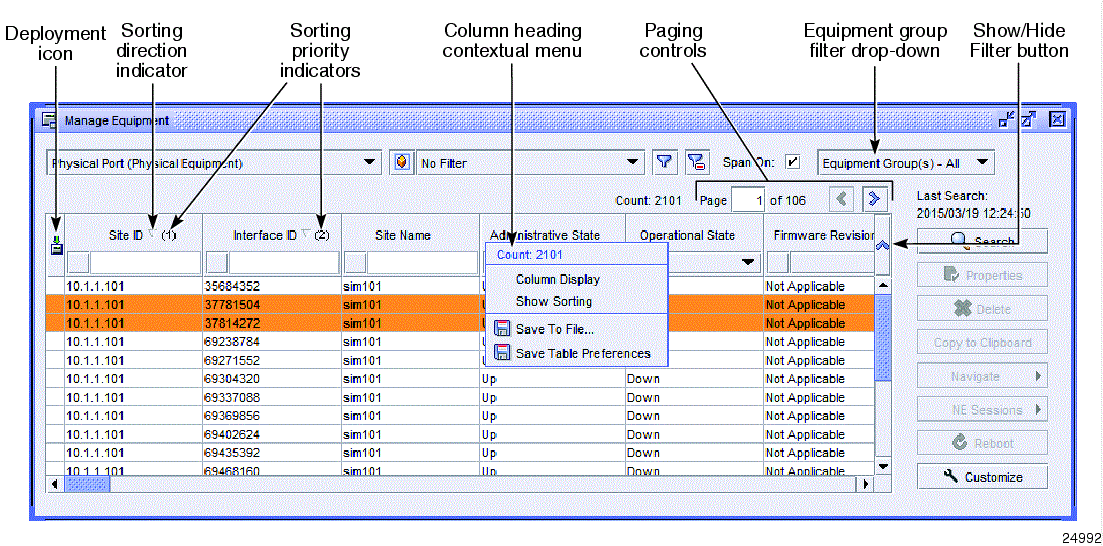To manage the display of listed information
Purpose
Perform this procedure to configure and save display preferences for list forms. You can resize and rearrange the sequence of columns, and remove columns that are not required. You can sort lists based on a selected column (attribute), and choose to display objects in ascending or descending order.
You can save listed information to a file; see To save listed information to a file.
The following table describes the order in which different types of data are sorted from the top of the column to the bottom, based on the direction of the arrow in the column header.
Table 1-4: Sorting listed information
|
Entry type |
Down arrow (Descending) |
Up arrow (Ascending) |
|---|---|---|
|
Numbers only |
Sorted from the lowest number to the highest number |
Sorted from the highest number to the lowest number |
|
Letters |
Sorted left to right, character by character, in alphabetical order |
Sorted left to right, character by character, in reverse alphabetical order |
|
Alphanumeric |
Sorted left to right, character by character, in the following order: from 0 to 9, then in alphabetical order |
Sorted left to right, character by character, in the following order: in reverse alphabetical order, then from 9 to 0 |
|
Alphanumeric for IP Address fields 1 |
Addresses are sorted first by type, then alphanumerically from the lowest to the highest number. For example, IPv4, IPv6 and DNS, in the following order: |
Addresses are sorted first by type, then alphanumerically from the highest to the lowest number. For example, DNS address, IPv6, IPv4 in the following order: |
|
Special characters |
Sorted left to right, character by character. The following characters are sorted in the following order before numbers, and uppercase and lowercase letters in a list: (space) ! # $ % & ‘ ( ) * + , . / The following characters are sorted in the following order after numbers in a list, but before uppercase and lowercase letters: : ; < = > ? @ The following characters are sorted in the following order after numbers, and uppercase and lowercase letters in a list: { | } ~ |
Sorted left to right, character by character. The following characters are sorted in the following order before numbers, and uppercase and lowercase letters in a list: ~ } | { The following characters are sorted in the following order before numbers in a list, but after uppercase and lowercase letters: @ ? > = < ; : The following characters are sorted in the following order after numbers, and uppercase and lowercase letters in a list: / . , + * ) ( ‘ & % $ # ! (space) |
|
Blanks |
Blank entries are placed first at the top of the list. |
Blank entries are placed last at the bottom of the list. |
Notes:
The following figure describes the features of a list form.
Figure 1-12: List elements

Steps
1 |
Open a list form and choose an object type. The columns specific to the object type are displayed. |
2 |
Configure column display preferences. Perform any of the following:
|
3 |
Configure a filter if required and click Search to generate a list. The total number of listed items is indicated by the Count value displayed on the form and in the contextual menu for column headings. |
4 |
Hide the simple search fields in the column headings. Click on the Show/Hide Filter button. |
5 |
Navigate multiple pages. When a list uses multiple pages, the paging controls are available. Click on the paging arrows to move forward or backward one page at a time, or enter a page number to jump to a specific page. The page number and total page count are shown on the form. You can specify a user preference for the number of items to display on a page; see To configure NFM-P user preferences . |
6 |
Configure sorting preferences. Lists are sorted top-to-bottom based on selected column attributes. You can display sorted results in ascending or descending order; see Table 1-4, Sorting listed information . When no column is explicitly selected for sorting, the first column at the left of the table is used. Perform one of the following:
|
7 |
Save your column display and sorting preferences.
End of steps |